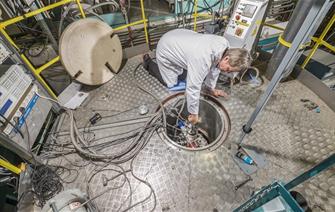
English portal Stereo rejects the sterile neutrino hypothesis
The physicists in stereo collaboration are categorical: If there really are anomalies in the neutrinos emitted by nuclear reactors, the sterilized neutrino is not the cause. Made up of researchers from CEA, CNRS, UGA, USMB, ILL and the German institute MPIK Heidelberg, this collaboration has tracked this particle for six years, without finding any trace, thanks to a unique experiment to study neutrinos from the ILL nuclear reactor.
This experience puts an end to years of interrogation. The existence of the sterile neutrino is indeed a natural extension of the Standard Model that particle physicists have been developing since the second half of the 20th century.H century. This particle, which makes it possible to explain physical phenomena that are still misunderstood, such as dark matter, and physicists believe that they have discovered traces of it in many experiments with nuclear reactors, in the form of a deficit of neutrinos resulting from fission compared to the prediction.
To unequivocally test this hypothesis of sterile neutrinos and characterize them, the researchers in the stereo collaboration turned to a very intense and controlled source of neutrinos, the high-flux reactor at ILL in Grenoble. Just ten meters from the reactor core, they placed a series of six identical detectors, taking advantage of the knowledge accumulated over several generations of experiments. Isolated from the external environment, these detectors were ideally positioned to search, with unprecedented precision, for the signature of sterilized neutrinos: far from the simple imperfection of standard neutrinos, changes in the energy distribution were to appear. ” This lack of reactor neutrinos reinforced other anomalies observed in other experiments. The sterilized neutrino likely opened the way to new physics and we thought it was within the scope of the measurement; We are fully invested in this endeavour explains David Lhuillier, a CEA physicist and spokesperson for the experiment. For 4 years, from 2017 to 2020, followed by 2 years of studying the data, 107,558 neutrinos were thus observed, but without any trace of a sterile neutrino.
Illustration of the STEREO experiment conducted by Loris Scola. The tomographic view of the detector shows the various layers of protection put in place to mitigate external background noise. The detector core consists of 6 identical cells positioned between 9 and 11 meters from the embedded core of the ILL, shown here by the intense Cerenkov light it stimulates in the reactor pool water. Neutrino interactions induce tiny flashes of light in the shimmering fluid that fills the cells, whose reflective walls allow light to be collected until it reaches the photomultipliers mounted on top. Above STEREO is a wide channel filled with 6 meters of water and connected to the pool, providing crucial protection against cosmic radiation.
It remained to explain in another way the deficiency, which always exists, of the neutrinos emitted during the radioactive decay of the fission products. The accuracy of the stereo measurements has the team pointing in another direction: It’s not the experiments that detect neutrinos but the nuclear data used to predict decay that may be biased.
The energy distribution of neutrinos from uranium-235 fission provided by stereo becomes reference data, motivating an extensive program of re-evaluation of the beta emissions of fission products described in nuclear databases. This program, for example, will make it possible to more accurately understand the phenomena at work during current or future reactor shutdowns. The stereo results also lay a solid foundation for future generations of experiments with reactors, for potential monitoring of reactors by measuring the neutrinos emitted, to study the mass hierarchy of these neutrinos or to further test the model at record low energy.
STEREO is a Franco-German experiment designed and operated by a team of scientists from CEA’s Ervaux Institute in Saclay, the Laue-Langevin Institute in Grenoble, the Annecy Laboratory for Particle Physics (LAPP, CNRS/USMB), the Grenoble Subatomic Physics and Cosmology Laboratory (LPSC) , CNRS/UGA), and the Kernphysik Max-Planck Institute in Heidelberg, Germany (MPIK).

“Organizer. Social media geek. General communicator. Bacon scholar. Proud pop culture trailblazer.”

